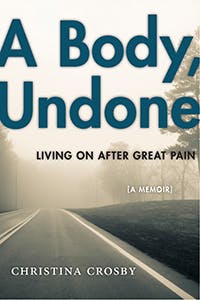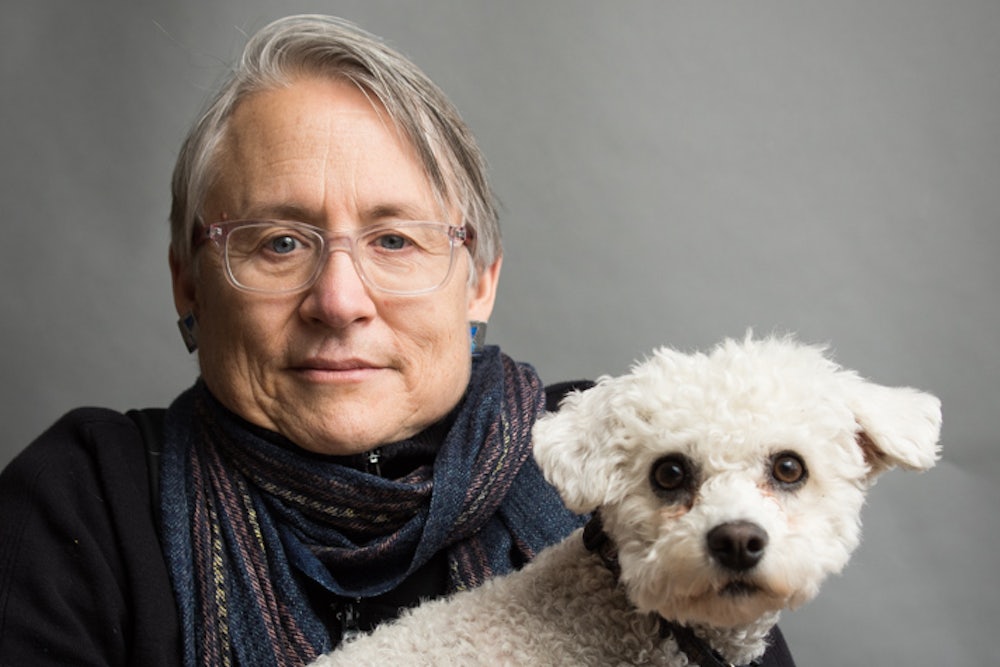“When Maggie walked into the hospital room she said, ‘You’re beautiful,’” Christina Crosby writes in her new memoir of paralysis, A Body Undone. “I didn’t believe her, but I loved her for saying it, nonetheless.”

The Maggie here is Maggie Nelson, the poet and memoirist, who has written extensively about her friendship with Crosby—notably in last year’s The Argonauts, an autobiographical reckoning of gender and motherhood. The relationship between the two women is clearly one of immense tenderness and intellectual generosity. Nelson writes of Crosby with gentle admiration; Crosby writes about Nelson with the kind of delighted pride that you usually only hear from parents.
A Body Undone is a very different book from Nelson’s, and Crosby is a very different writer: Her work is more academic in its habits and more withholding in its confessions. But what Crosby’s project shares with Nelson’s is that both women have found themselves in the uncomfortable position of being seen as a genre of person—a mother for Nelson, a quadriplegic for Crosby—whose life does not fit within genre conventions. Both write through a feeling of being unseen, and both of their books can be read as defiant protests against misidentification.
Crosby’s memoir begins, as she says disability stories always must, with her accident. An English professor at Wesleyan, Crosby found herself with a few spare hours one afternoon in the fall of 2003, just a few days after she turned fifty. She decided to go for a bike ride. She was always athletic: She grew up playing sports and wrestling with her brother, and her account of her life is saturated with savoring descriptions of sex, exercise, and other physical joys. She’d been a cyclist for years, going on long charity rides and buying elegant, light framed bikes.
Crosby remembers looking forward to her ride that afternoon; she doesn’t remember the twig getting caught in her wheel spokes. She was thrown forward, and landed on her chin. An onlooker called the ambulance. “The wire-rim glasses I was wearing were deeply enough embedded in the bridge of my nose to leave a dark half-moon scar between my eyebrows,” she says. But what permanently changed her life was the fracture to her spine. She was left with little movement in her arms and hands, and almost none below the breastbone; she will never walk again. Physical therapy enabled her to eventually turn the pages of books, but years later her fingers are still stiff. They move haltingly, as when a child first tries to use chopsticks.
What’s striking about Crosby’s telling isn’t the drama of her injury, but how the cataclysm of the accident seems to lie beyond words. Her descriptions of her life circle around what the accident did to her, but never succeed in grasping it completely. Nelson, for her part, devoted a third of her early poetry collection Something Bright, Then Holes, to a section of poems called “In the Hospital for Special Care,” about visiting Crosby in the weeks following the accident. But even there the verse is marked with a blank helplessness:
Not one single scratch on your helmet
You took the whole fucking fall
on your chin, the snap back of your head
caused the fracture, the space that’s injured
is no bigger than a chocolate bar and yet
here we are.
The failure to describe the incident is a recurring theme in Crosby’s thought about her own injury. She comes to understand incommunicability and isolation as the emotional touchstones of her paralysis. “Pain seems on the other side of language,” she writes. “I feel an unassuageable loneliness, because I will never be able to adequately describe the pain I suffer, nor can anyone accompany me into the realm of pain.”
Crosby has been in pain for 13 years since her accident. She describes the coffee that she drinks constantly to combat the sedative effects of her painkillers; she repeatedly returns to the illicit, almost terrifying relief that she felt one night in the hospital, when her partner Janet, out of sight of the doctors, crushed a Percocet pill and tapped the powder directly into her IV. Crosby calls her constant neurological distress by various names: Sometimes it’s a buzzing, sometimes a fizzing, sometimes a brittle sensation, “like crinkly hot Saran wrap.” But none of these words are quite good enough, none of them relieve her from the need to explain that no, it’s not like that. Perhaps the most profound lesson of Crosby’s book is how lonely pain is, how it can subvert all your other forms of relation. You can write about it all you want, but nobody can be in your body with you.
One of the chief frustrations Crosby expresses about her post-paralysis life is that the stories of disability that are available for her to define her life by are unacceptable, dehumanizing, and foreign to her own experience. She writes that with her book, she aims to “ironize any happy idea that disability leads to profound insight or higher understanding…That arc carries the troubled subject through painful trials to livable accommodations and lessons learned, and all too often sounds a note triumphant,” she writes. “Don’t believe it.”
Above all, Crosby is unequivocal in asserting that her paralysis is a tragedy, that it has lessened her life. This assertion of grief for her disabled body actually places Crosby in opposition to the views of many disability activists, who in recent years have encouraged the celebration of disabled bodies and argued that disability is a socially constructed status. This line of thought that has linked work in the field of disability studies to that of queer and feminist thinkers, who celebrate difference among marginalized groups and resist assimilation to mainstream standards of living. Pain, in the parlance of these thinkers, can be understood as formative, as illuminating, or as containing its own truths and forms of pleasure. As Carolyn Heilbrun has written, feminist autobiography “tends to find beauty even in pain and transform grief into spiritual acceptance.” Crosby refuses to do this. Her response to her quadriplegia is dismay, frustration, and rage.
And so Crosby’s A Body Undone can read like a litany of rejections of all the people she might be understood to be. She is emphatically not the morally enlightened quadriplegic, not the person whose suffering can be made into a vessel for other people’s metaphors. Her book’s drama lies in trying to decode who she really is.
Towards the end of A Body Undone, Crosby crystalizes her reading of her life by defining it in genre terms. She argues that conventional narratives of disability—the kind that preach distancing oneself from the bereaved former life, moving towards accommodation and acceptance, and harnessing pain in the service of personal growth—tend to follow the trajectory of Victorian realism, the genre she built her academic career around. “Realism progresses through chronologically sequential time toward a knowable future, and creates an imagined world you find continuous with your own.” Crosby recalls her partner reading Middlemarch aloud to her in the hospital, how she quipped at Janet, “Of course you have to start with the preface!”
But this idea of narrative sequence is contradicted by Crosby’s own experience of paralyzed life, an experience characterized by incommunicability, powerlessness, and loss of chronological momentum. She claims that her life is instead following the patterns of a horror story, where “the boundary between the real and the fictive, the interpretations of experience by the audience and the characters, is continually drawn and effaced.” It can’t be communicated, it can’t be interpreted. She characterizes her paralyzed life as one of generalized fear and pain, detached her from the realm of the ordinary.
A Body Undone is a messy book, and it’s not entirely a good one. There are parts that seem meandering, distracted, or misguided—one chapter, bizarrely, is dedicated to biographies of Crosby’s dogs, including a Labrador she had in graduate school named “Shameless Hussy.” It might be most generous to say that in its formal clumsiness, the book is a portrait of a real mind at work.
But like a lot of memoirs, A Body Undone is less interesting for the thoughts that it contains than for the gesture that Crosby made in writing it. If, as Heilburn asserts, a woman writes her own life by living it, then Crosby’s accident took away much of her capacity for authorship; it made her at once less capable of dictating the plot of her life and more vulnerable to other people’s wrong understandings of it. Her memoir acts as both an analysis of her life before the accident and an attempt to reclaim her right to dictate what will come after it. It is a way of saying No, it’s not like that; it’s like this.
Still, Crosby’s accident, and the fact of bodily vulnerability that it emphasizes, make this effort feel partial, endangered. How much do we really control our own lives if fate or accident can always intervene to kill us, to paralyze us, or just to change our plans? Before she was paralyzed, Crosby was awake to bodily joys—she loved to flirt, drink wine, exercise, and fuck. These are quotidian pleasures, but they are important ones, the kind that structure and animate our lives. Her accident took them away from her in a matter of seconds. Crosby is not an emotionally manipulative writer: She wants her readers to understand her pain, not to pity it. But I wept when I reached the part of the book where she reprints a poem that Nelson wrote about her, titled “Morning En Route to the Hospital:”
Snow wafts off the little lake
along Route 66, momentarily encasing the carin a trance of glitter
Live with your puny, vulnerable self
Live with her.
